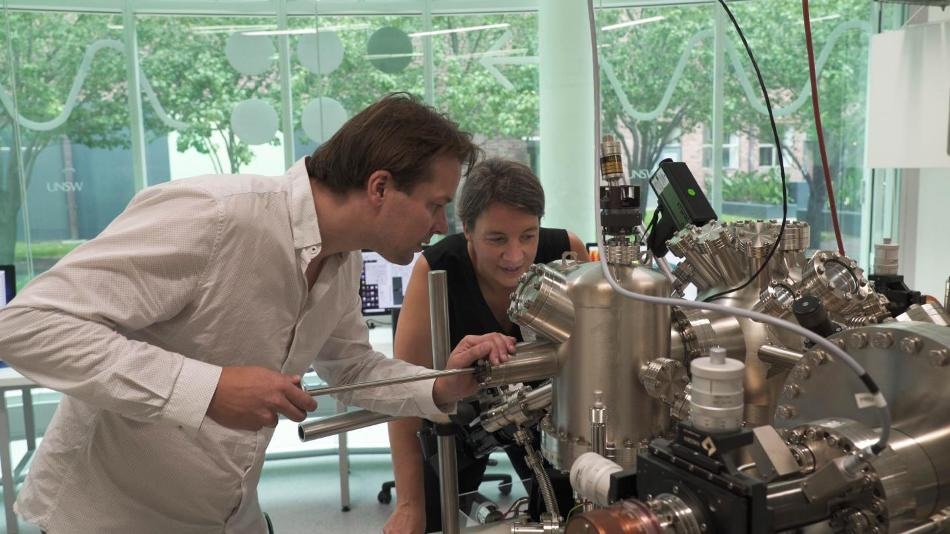Jan 8 2019
For the first time, UNSW scientists at the Centre of Excellence for Quantum Computation and Communication Technology (CQC2T) have demonstrated that it is possible to create qubits with atomic precision in a 3D device—another significant step toward achieving a universal quantum computer.
 Study authors Dr Joris Keizer and Professor Michelle Simmons. (Image credit: UNSW Sydney)
Study authors Dr Joris Keizer and Professor Michelle Simmons. (Image credit: UNSW Sydney)
The scientists, headed by Professor Michelle Simmons, 2018 Australian of the Year and Director of CQC2T, have shown that it is feasible to extend their atomic qubit fabrication method to several layers of a silicon crystal—accomplishing a crucial component of the 3D chip architecture introduced by them to the world in 2015. The new study has been reported in Nature Nanotechnology on January 8th, 2019.
The team is the first to show the practicability of an architecture in which atomic-scale qubits are aligned and used to control lines—typically very narrow wires—within a 3D design.
Furthermore, the members of the group could align the distinct layers in their 3D device with nanometer precision—and demonstrated that it is possible to read out qubit states with the so-called “single shot,” that is, within just a single measurement, with extremely high fidelity.
This 3D device architecture is a significant advancement for atomic qubits in silicon. To be able to constantly correct for errors in quantum calculations—an important milestone in our field—you have to be able to control many qubits in parallel. The only way to do this is to use a 3D architecture, so in 2015 we developed and patented a vertical crisscross architecture. However, there were still a series of challenges related to the fabrication of this multi-layered device. With this result we have now shown that engineering our approach in 3D is possible in the way we envisioned it a few years ago.
Professor Michelle Simmons, Director, CQC2T
In this study, the researchers have shown ways to create a second control plane or layer on top of the first layer of qubits.
“It’s a highly complicated process, but in very simple terms, we built the first plane, and then optimised a technique to grow the second layer without impacting the structures in first layer,” explained Dr Joris Keizer, who is a CQC2T researcher and co-author of the study.
“In the past, critics would say that that’s not possible because the surface of the second layer gets very rough, and you wouldn’t be able to use our precision technique anymore—however, in this paper, we have shown that we can do it, contrary to expectations.”
The researchers also showed that these multiple layers can be aligned with nanometer precision.
If you write something on the first silicon layer and then put a silicon layer on top, you still need to identify your location to align components on both layers. We have shown a technique that can achieve alignment within under five nanometers, which is quite extraordinary.
Dr Keizer, Researcher, CQC2T
Finally, the team could measure the 3D device’s qubit output in a single shot—that is, with a single, precise measurement—instead of depending on averaging out millions of experiments.
“This will further help us scale up faster,” explained Dr Keizer.
Towards commercialization
According to Professor Simmons, who is also the founder and a director of SQC, this study is a milestone in the field.
We are working systematically towards a large-scale architecture that will lead us to the eventual commercialisation of the technology. This is an important development in the field of quantum computing, but it’s also quite exciting for SQC.
Professor Michelle Simmons, Director, CQC2T
From May 2017, Silicon Quantum Computing Pty Limited (SQC), Australia’s first quantum computing company, has been striving to develop and commercialize a quantum computer based on a collection of intellectual property created at CQC2T and its own proprietary intellectual property.
“While we are still at least a decade away from a large-scale quantum computer, the work of CQC2T remains at the forefront of innovation in this space. Concrete results such as these reaffirm our strong position internationally,” Simmons concluded.
Quantum scientists demonstrate world-first 3D atomic-scale quantum chip architecture
Video credit: UNSW Sydney